Dashi 101: A Guide to the Umami-Rich Japanese Stock
Here's what you need to know about this simple seaweed-based stock that's central to many Japanese dishes.
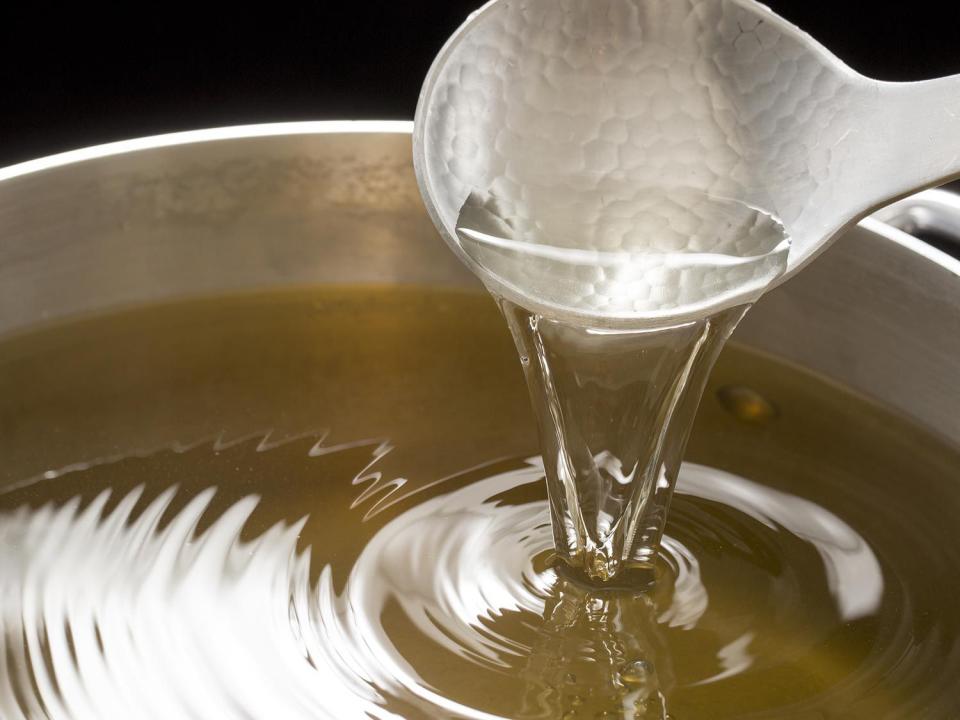
Serious Eats / J. Kenji López-Alt
If you've ever eaten Japanese food, there are two things I can almost guarantee you've tasted. The first is rice, which you've doubtless always known when you've seen it. The second is dashi, which may well be the unsung umami hero that you've never actually recognized. The simple seaweed-based stock is central to many of Japan's most popular dishes, particularly the brothy soups and dipping sauces served with noodles like soba, udon, and many types of ramen. You can even find it used as the cooking liquid for sushi rice, or incorporated into yakitori glazes. And yet, despite the widespread popularity in Western kitchens of Japanese ingredients like soy sauce, miso paste, and teriyaki marinade, dashi appears to have been largely overlooked. When acknowledged at all, it's often treated with the same hesitancy as veal stock—something important and delicious, but best left to professionals.
In large part, that's because Japanese chefs can be notoriously devoted to perfecting their dashi—a process that can take years, if not a lifetime. The key is to realize that this is true of the professional approach to most, if not all, Japanese food. I'd strongly encourage home cooks to work with different expectations and ideals in mind. Because while there is assuredly a world of detail and finesse that one can explore with dashi, on a very basic level, it's remarkably easy.
It's also an incredibly versatile stock, one that adds significant yet subtle flavor to a wide variety of savory dishes. I turn to dashi when making miso soup, ramen broth, and tare (dipping sauce). And, while it's obviously central to other distinctly Japanese dishes like chawanmushi (a savory egg custard) and nimono (simmered dishes), it can be equally useful in Western preparations.
I gravitate toward using dashi in almost any dish that can benefit from a flavorful liquid. This might raise the hackles of a few of purists, but I've been known to use dashi as the cooking liquid for polenta, as the poaching broth for fish à la nage, or as part of the liquid when steaming clams for clam sauce (which then pairs especially well with that dashi-based polenta). I also use dashi as a base for any fish fumet. Though the most common form of dashi incorporates dried fish, there are also equally satisfying vegan variations that make excellent alternatives to vegetable stock.
What Is Dashi, Exactly?

Serious Eats / Vicky Wasik
The word "dashi" is often used to refer to a stock made from mild oceanic kombu (edible sheets of dried seaweed) and smoky katsuobushi, shavings of dried, smoked, and sometimes fermented skipjack tuna or bonito. That said, dashi can also incorporate a range of other ingredients, including dried shiitake mushrooms and other dried-fish products, like niboshi (dried sardines).
We use the word "stock" to describe dashi, but it bears little resemblance to the stocks usually found in Western kitchens. The closest analogues are vegetable stocks and fish fumets, given their short cooking times, but even these are vastly more labor-intensive to make than the dashi used in a typical Japanese kitchen. No matter who is making dashi, whether it's a three-Michelin-star chef or my grandmother, the active process takes minutes, not hours. Although there are drastic differences in the way different people approach making dashi, the fundamentals are the same, and they involve infusing water with the flavors of kombu and katsuobushi (and/or niboshi and dried shiitakes, if that's your preference), sometimes without using any heat at all.
Before we go any further, it's important to clear up some of the ambiguity that surrounds dashi. For one thing, while most Japanese home cooks use dashi every single day, many of them use instant dashi granules, produced by large food companies like Ajinomoto, rather than the more traditional sheets of kombu and bonito shavings. Even those who make their own fresh dashi every day (as my grandmother does), as well as most restaurants, will often use shavings of dried and smoked bonito that has not undergone the fermentation process.
The range in quality of dashi is as wide as that of stock in Western kitchens—think of the difference between bouillon cubes and the gelatin-rich chicken or veal stock painstakingly made in the best French restaurants. At the most refined Japanese restaurants (like Michelin-starred establishments, or those serving the formal, coursed-out meals that fall under the designation kaiseki), the kombu and katsuobushi used are of a very high quality—the kombu aged for several years, the katsuobushi freshly shaved before each use.
What Makes Dashi So Important?
Dashi is the embodiment of umami, the fifth taste (after sweet, sour, salty, and bitter) that was identified in 1908 by the Japanese chemist Kikunae Ikeda. At a recent talk hosted by the Japan Society, the celebrated Japanese chef Kiyomi Mikuni described how a typical dashi made from kombu and katsuobushi contains not just the glutamic acid isolated by Ikeda, but also inosinates, provided by the katsuobushi. According to Mikuni, research has shown that glutamates and inosinates interact not just in an additive way but in a multiplicative way, essentially becoming eight times more flavorful when tasted together. (Guanylates, a separate category of flavor compounds, are present in mushrooms like shiitakes and kinoko mushrooms, and have a similar multiplicative effect on taste when eaten in conjunction with glutamates.)*
*For more information about these interactions, check out the Umami Information Center. Keep in mind, though, that much of the information here is provided by the Ajinomoto Corporation, which has a vested interest in the subject.
As such, dashi can basically be viewed as a liquid flavor enhancer created with whole ingredients, which is why it's used in a great number of savory dishes in the Japanese recipe book. But different cooks treat the kombu and katsuobushi in different ways, so let's tackle them separately.
Kombu
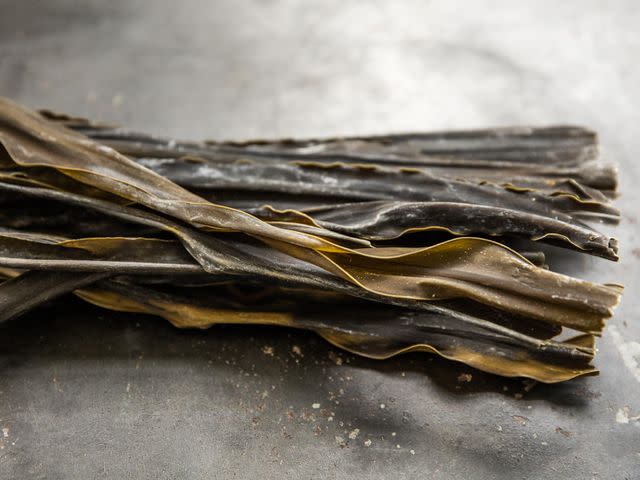
Serious Eats / Vicky Wasik
Though a number of different species of kombu are used in culinary applications, the method for turning any one of those species into dashi should be the same, in theory. But in fact, chefs and cooks take a variety of approaches, and the inquisitive minds over at the Cooking Issues blog put them to a definitive test several years ago. They found that sealing 10 grams of kombu with one liter of water in a bag and heating it at a constant 65°C (149°F) yielded the most flavorful dashi. For those who don't have immersion circulators and aren't inclined to vacuum-seal their dashi, the third-place approach is the most instructive: Leave 10 grams of kombu soaking in one liter of water overnight, then bring the combination to a simmer and strain it. This is the method most commonly used in Japanese home kitchens; dried sardines or shiitakes, if used, are often added to the cold infusion along with the kombu.
But at the highest levels of Japanese cuisine, you'll find other approaches. Nihonryori RyuGin, a three-Michelin-star fusion kaiseki restaurant in Tokyo headed by Chef Seiji Yamamoto, publishes YouTube tutorials for some of their signature dishes, including one that prominently features an ichiban dashi (more on this in a moment). According to that video, the restaurant soaks kombu in cold water for six hours, then removes that kombu, without heating it at all.
Meanwhile, in his Ivan Ramen cookbook, Chef Ivan Orkin calls for soaking kombu at least two hours and up to overnight in water, then bringing the water to 140°F (60°C) before straining out the seaweed. The discrepancies in these cases are, in a sense, a matter of taste, but also likely due to quality differences in the kombu used by Nihonryori RyuGin, Ivan Orkin, and the Cooking Issues folks, as well as the different applications in which the dashi will ultimately be used.
Another, quicker way to infuse kombu in water is to simply place it in cold water and bring it to a simmer. The Cooking Issues test deemed this method essentially worthless, but it's important to remember the multiplicative effect of glutamates and inosinates—while the kombu dashi produced by this method may be insipid on its own, it'll get a big boost from the addition of katsuobushi.
The one fundamental rule of infusing kombu for dashi is that the water should never be brought to a boil. Cooking the combination at or above boiling temperatures immediately results in a bitter flavor—one that's almost impossible to mask, even in something as assertive as a ramen broth.
Katsuobushi
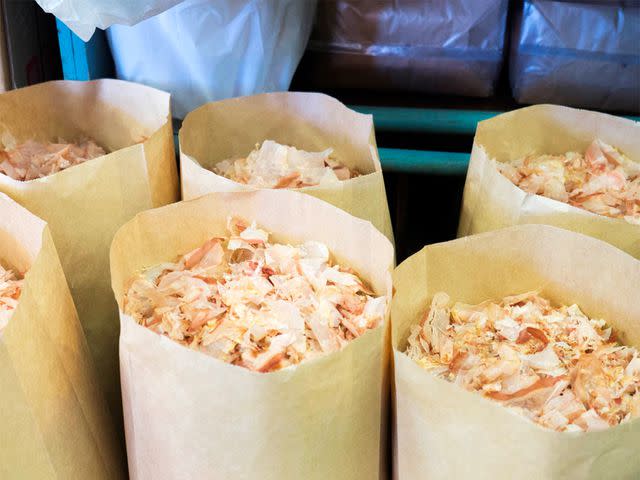
Serious Eats / Daniel Gritzer
While the proscription against boiling kombu is universally accepted, I was hard-pressed to find carefully tested temperature guidelines for katsuobushi. Some chefs call for letting the shaved katsuobushi sit in the hot dashi for no longer than a few seconds. Others say to let it sit for five minutes, and still others call for simmering the flakes. Nihonryori RyuGin steeps its katsuobushi for just seven seconds, but, importantly, the bonito is shaved off of solid blocks using a specialized machine, producing thicker flakes than what's commonly available in stores. Because the flavor of the bonito dissipates quickly once it's shaved, this shaved-to-order katsuobushi is higher in quality than most of the stuff used by home cooks, or even by less upscale restaurants.
Mikuni, in his talk at the Japan Society, demonstrated how he, too, uses blocks of whole katsuobushi fillets. But instead of Nihonryori RyuGin's machine, he uses something similar to this box (available here on Amazon), and adds the shavings to kombu dashi once it's reached a simmer. He then turns off the heat and lets the shavings settle to the bottom of the pot, which takes about three minutes, before finally straining them out. Orkin, on the other hand, adds his katsuobushi shavings to 176°F (80°C) dashi for three minutes before removing it from the heat and straining.
I decided to set up a small experiment of my own, using Kenji's recipe for a basic dashi. I began by cold-infusing three identical 10-gram batches of kombu in three pots filled with 500 milliliters of water for four hours. I then brought all three to a simmer in separate pots, discarded the kombu, and added 10 grams of katsuobushi flakes to each.
I took the first pot off the heat immediately. The second I maintained at a steady simmer for five minutes, while the third I brought to a boil for the same period of time. After the five minutes was up, I strained all three pots through coffee-filter-lined strainers into separate containers. Once they had cooled to room temperature, I gave them a taste.
The first tasted exactly as I expect a dashi to taste, with a clean, oceanic flavor from the seaweed underlying the more overt, smoky, and slightly fishy taste of the katsuobushi. The second had a much stronger katsuobushi flavor, with a very faint backdrop of kombu. The third, boiled dashi tasted only of katsuobushi, and was surprisingly salty, as if the hard boil had leached out whatever salt was in the shavings. To my taste, it wasn't off-putting. In fact, it was kind of delicious—at least at first.
But then an entirely unpleasant sour, fishy aftertaste took over, and lingered. The simmered dashi had a similar lingering flavor, although it wasn't nearly as pronounced, and the unboiled dashi left only a vaguely umami flavor, somewhat akin to the taste in your mouth after you eat a couple cherry tomatoes.
I made a simple miso soup with each of the three batches, and that same aggressively unpleasant aftertaste persisted in the soup made with the boiled dashi. The soup made with the simmered dashi had a slight sourness, while the soup made with the unboiled dashi—far and away my preferred version—left only the flavor of miso in my mouth.
Ichiban Versus Niban Dashi

Serious Eats / Vicky Wasik
One important thing to note is that many of the instructions above are specifically for making a type of dashi known as ichiban dashi, which literally means "first dashi." The kombu and katsuobushi flakes used to make this first dashi are typically used again to make niban dashi, which is, you guessed it, "second dashi." The distinction between the two is of the utmost significance in Japanese fine dining, in which the ichiban dashi is used only in clear soups and is prized for its color and clarity as well as its clean flavors and aroma. Meanwhile, the niban dashi is used as a building block of flavor in stews, glazes, sauces, and other applications in which refinement is less crucial.
In less exalted arenas, such as ramen shops, the first dashi will be used as a component of the ramen broth, and the second dashi will be used to stew pork or as part of the marinade for eggs. Similarly, for a home cook, the first dashi is often used for miso soup in the morning, and the second dashi will be made only if there's some plan to stew or braise something later in the day. Otherwise, the spent kombu and bonito flakes will be repurposed in some other way. Kombu can be sliced thinly and tossed into salads, used to marinate or cure pieces of fish, or wrapped around cuts of fish before they're braised; spent bonito flakes can be stewed in a mixture of soy sauce, sake, and mirin and used as a topping for rice. Or, as often happens, they can simply be discarded.
To make a niban dashi, simply place the used kombu and katsuobushi in a clean pot with roughly the same amount of water used for ichiban dashi, then bring the mixture to a simmer and hold it there for 10 minutes. Some cooks will then add more katsuobushi to improve the flavor, and strain the mixture once again.
Buying Dashi Ingredients
In the past, it may have been somewhat difficult to purchase ingredients for dashi in the United States, but nowadays, both kombu and katsuobushi shavings can easily be found in the Asian sections of most large grocery stores, or, failing that, online. Here's a quick visual guide to what you'll find.
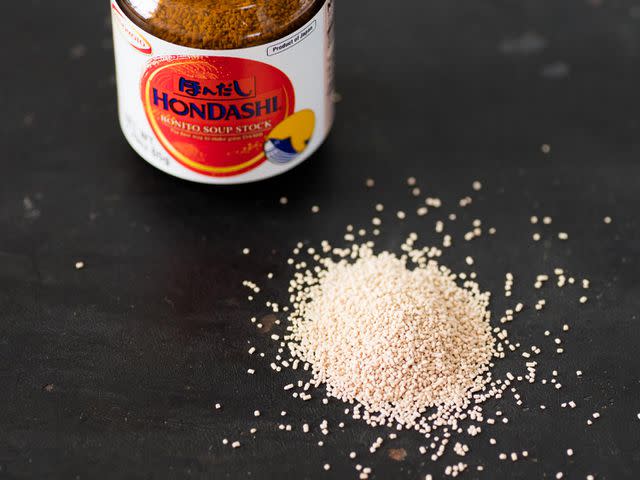
Serious Eats / Vicky Wasik
First off is the instant dashi granules produced by Ajinomoto. Those who eschew monosodium glutamate in all its forms will want to avoid this product, but if you have no issue with MSG (we certainly don't!), then it's a handy thing to have around. Both David Chang, of Momofuku fame, and our own J. Kenji Lopez-Alt say that it can be a lifesaver in a pinch—we even call for it in some recipes.
Ajinomoto Hondashi
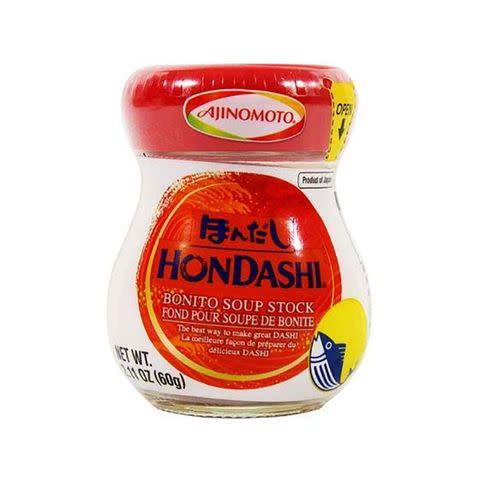
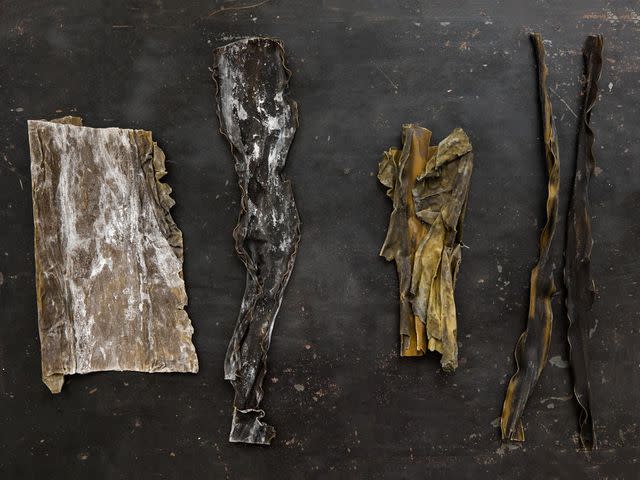
Serious Eats / Vicky Wasik
Next up are the different varieties of kombu, which, at a Japanese specialty market I recently visited in New York City, ranged in price from a dirt-cheap $1.59 for two ounces to a rather expensive $18.99 for three and a half ounces. Kombu can fetch far higher prices than that, but it's unlikely you'll run into any of those premium kombus at the grocery store.
These kombus represent different species and grades, but as a general rule, the kombu that has more of a powdery, whitish substance on its surface will usually be cheaper. Which one should you buy? For most people, the cheapest one will do, particularly if you're looking to use dashi only as a flavor foundation upon which to build a braise, broth, or sauce. But if you're setting out to make a pristine, delicately flavored clear soup, you may want to invest in a pricier package.
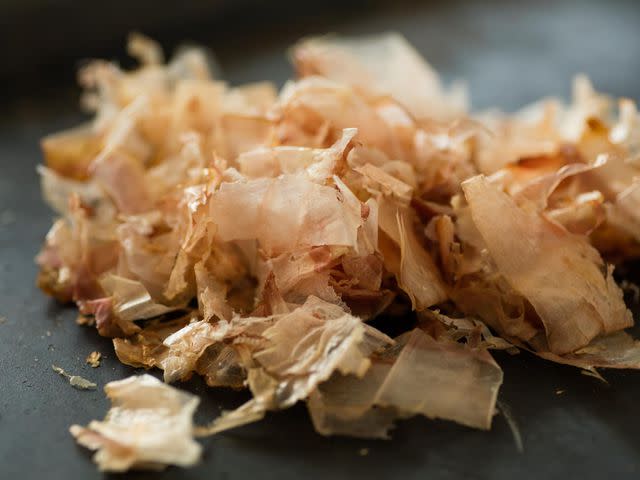
Serious Eats / Vicky Wasik
Finally, there are the dried-fish options. In most supermarkets' Asian sections, you'll probably find katsuobushi flakes that are on the small side. These can be used for making dashi; for topping any number of dishes, from okonomiyaki and grilled eggplant to soft tofu; or for mixing up with soy sauce to fill rice balls or top rice bowls. But they're intended primarily for non-dashi purposes. For dashi, the larger and wider katsuobushi shavings are typically used, although they can also be used as a topping.
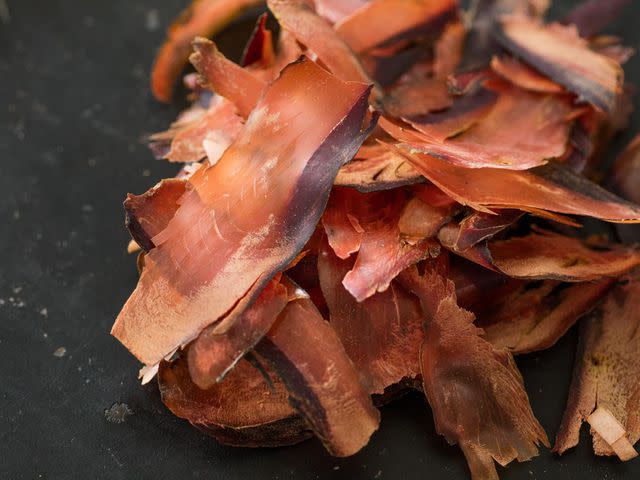
Serious Eats / Vicky Wasik
Then there's the katsuobushi that's shaved rather thickly, called atsukezuri, which is intended solely for making dashi. Given this product's single-purpose nature, I wouldn't necessarily recommend it to those who simply want to get their feet wet, but it's perfect for cooks looking to experiment with clear soups and broths for udon, or with homemade tsuyu for dipping soba.
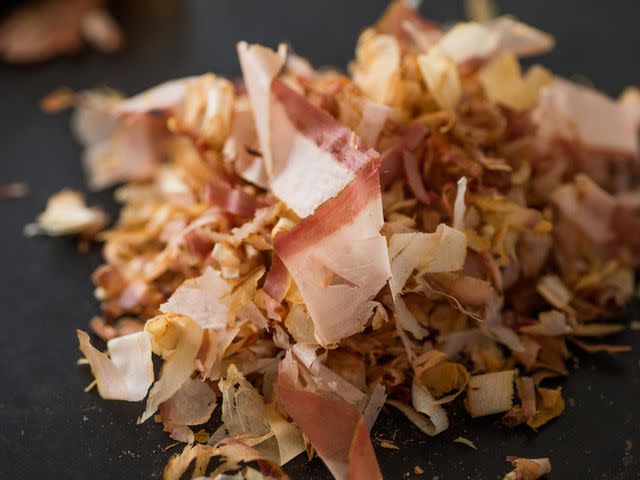
Serious Eats / Vicky Wasik
You can also find packets, like the one above, that contain not just katsuobushi but other fushi, or dried-fish shavings. The mixture pictured above combines dried bonito, dried mackerel, and dried scad, but variations abound. Though similar to katsuobushi, the flavor is stronger and more complex. Though designed primarily for soup stock, this type of thin-shaved fushi can be substituted for katsuobushi as a feathery topping on cooked dishes.
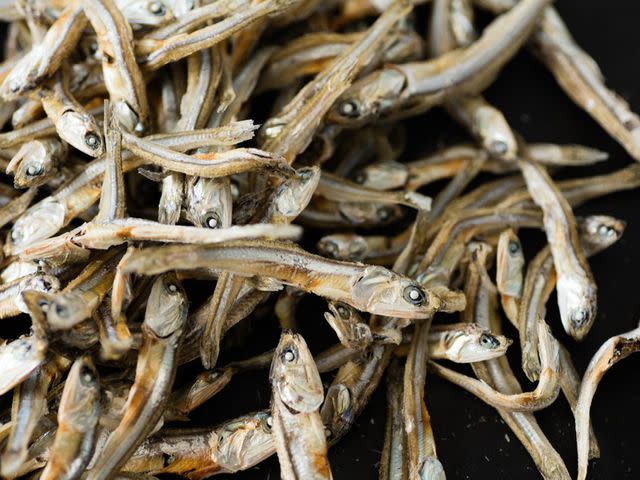
Serious Eats / Vicky Wasik
As a bonus, I picked up a pack of dried niboshi (the aforementioned sardines), just because they're delicious and can add another layer of complexity in a dashi. The conventional wisdom says to decapitate and gut the dried sardines before soaking them, along with kombu, in water overnight, as the heads and guts are supposed to be bitter. But some cooks, like my grandmother, omit that step entirely and still manage to produce a delectable dashi.
Bringing It All Together

Serious Eats / J. Kenji Lopez-Alt
So, now that you've got all your dashi ingredients, what should you do with them? First, make your dashi, of course. Then use it in an easy homemade miso soup. It'll be significantly better than anything you'll get from your local sushi takeout spot (and some of your higher-end places, too, depending on the quality of your miso). Try your hand at the 15-minute chicken- and egg-laden rice dish called oyakodon, or give its beef-centric cousin, gyudon, a shot.
But you don't have to limit yourself to Japanese dishes, particularly with a plain kombu dashi: Its subtle flavor lends itself to a number of applications, especially when combined with other ingredients that contribute inosinates or guanylates. One example, taken straight from ramen broth, is to use kombu dashi as a base for chicken stock, as the chicken will supply the inosinates that katsuobushi would provide in a more traditional dashi. (You can also simply steep kombu in warm chicken stock to draw out some of its glutamates, which is what Jack Nakamura does for his torigara ramen broth.) Vegetarians and vegans can use a kombu dashi to make a more savory vegetable stock, adding either fresh or dried mushrooms for extra flavor.
No matter what approach you take, may it be the first of many.
March 15, 2017